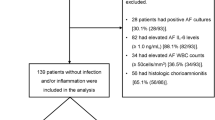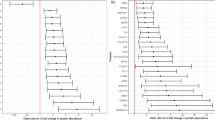Abstract
We aimed to identify novel biomarkers in amniotic fluid (AF) that predict the outcome of emergency cerclage in women with cervical insufficiency. This retrospective cohort study included 40 singleton pregnant women who received emergency cerclage for cervical insufficiency (17–25 weeks) and underwent amniocentesis. Label-free liquid chromatography-tandem mass spectrometry (LC-MS/MS) was used to identify AF proteins in pooled samples (n = 16) using a nested case-control approach. The six candidate biomarkers of interest were validated by enzyme-linked immunosorbent assays (ELISA) in the final cohort (n = 40). The differentially expressed proteins (DEPs) were analyzed by pathway analysis software. The primary outcome measure was failure of emergency cerclage [defined as spontaneous preterm delivery (SPTD) at < 34 weeks of gestation after cerclage placement]. Sixty-eight proteins were differentially expressed (P < 0.001) in AF from SPTD cases and near-term controls, of which 44 (64.7%) were upregulated and 24 (35.3%) were downregulated. Validation by ELISA confirmed that AF from women with cerclage failure contained significantly higher levels of myeloperoxidase, lactoferrin, glucose-6-phosphate isomerase, lipocalin-2, and lymphocyte cytosolic protein 1, the first four of which were independent of cervical dilatation at presentation. The five pathways with the most differentially regulated proteins were actin cytoskeleton signaling, acute phase response signaling, ILK signaling, glycolysis, and gluconeogenesis. Proteomic analyses of AF in this study identified DEPs and specific protein pathways related to poor prognosis after emergency cerclage for cervical insufficiency. Four novel independent biomarkers in AF for cerclage failure have been identified using proteomics.



Similar content being viewed by others
References
Lidegaard O. Cervical incompetence and cerclage in Denmark 1980-1990. A register based epidemiological survey. Acta Obstet Gynecol Scand. 1994;73(1):35–8.
McDonald IA. Cervical cerclage. Clin Obstet Gynaecol. 1980;7(3):461–79.
Park JC, Kim DJ, Kwak-Kim J. Upregulated amniotic fluid cytokines and chemokines in emergency cerclage with protruding membranes. Am J Reprod Immunol. 2011;66(4):310–9.
Romero R, Espinoza J, Erez O, Hassan S. The role of cervical cerclage in obstetric practice: can the patient who could benefit from this procedure be identified? Am J Obstet Gynecol. 2006;194(1):1–9.
Namouz S, Porat S, Okun N, Windrim R, Farine D. Emergency cerclage: literature review. Obstet Gynecol Surv. 2013;68(5):379–88.
Brown R, Gagnon R, Delisle MF, et al. Cervical insufficiency and cervical cerclage. J Obstet Gynaecol Can. 2013;35(12):1115–27.
Ehsanipoor RM, Seligman NS, Saccone G, Szymanski LM, Wissinger C, Werner EF, et al. Physical examination-indicated cerclage: a systematic review and meta-analysis. Obstet Gynecol. 2015;126(1):125–35.
Son GH, You YA, Kwon EJ, Lee KY, Kim YJ. Comparative analysis of midtrimester amniotic fluid cytokine levels to predict spontaneous very pre-term birth in patients with cervical insufficiency. Am J Reprod Immunol. 2016;75(2):155–61.
Jung EY, Park KH, Lee SY, Ryu A, Joo JK, Park JW. Predicting outcomes of emergency cerclage in women with cervical insufficiency using inflammatory markers in maternal blood and amniotic fluid. Int J Gynaecol Obstet. 2016;132(2):165–9.
Weiner CP, Lee KY, Buhimschi CS, Christner R, Buhimschi IA. Proteomic biomarkers that predict the clinical success of rescue cerclage. Am J Obstet Gynecol. 2005;192(3):710–8.
Hatakeyama Y, Miura H, Sato A, et al. Neutrophil elastase in amniotic fluid as a predictor of preterm birth after emergent cervical cerclage. Acta Obstet Gynecol Scand. 2016;95(10):1136–42.
Marek K, Jennings D, Tamagnan G, Seibyl J. Biomarkers for Parkinson’s [corrected] disease: tools to assess Parkinson’s disease onset and progression. Ann Neurol. 2008;64(Suppl 2):S111–21.
Suarez-Arroyo IJ, Feliz-Mosquea YR, Perez-Laspiur J, et al. The proteome signature of the inflammatory breast cancer plasma membrane identifies novel molecular markers of disease. Am J Cancer Res. 2016;6(8):1720–40.
Chen CD, Wang CL, Yu CJ, et al. Targeted proteomics pipeline reveals potential biomarkers for the diagnosis of metastatic lung cancer in pleural effusion. J Proteome Res. 2014;13(6):2818–29.
Li L, Zhang Z, Wang C, et al. Quantitative proteomics approach to screening of potential diagnostic and therapeutic targets for laryngeal carcinoma. PLoS One. 2014;9(2):e90181.
Govia RNM, Birse KD, Sepehri S, Khafipour E, Menticoglou SM, Burgener AD, et al. Amniotic fluid proteomic signatures of cervical insufficiency and their association with length of latency. Am J Reprod Immunol. 2018;80(5):e13030.
Lee SY, Park KH, Jeong EH, Oh KJ, Ryu A, Kim A. Intra-amniotic infection/inflammation as a risk factor for subsequent ruptured membranes after clinically indicated amniocentesis in preterm labor. J Korean Med Sci. 2013;28(8):1226–32.
Chang S, Kim YH, Kim YJ, et al. Taurodeoxycholate increases the number of myeloid-derived suppressor cells that ameliorate sepsis in mice. Front Immunol. 2018;9:1984.
Pavelka N, Fournier ML, Swanson SK, Pelizzola M, Ricciardi-Castagnoli P, Florens L, et al. Statistical similarities between transcriptomics and quantitative shotgun proteomics data. Mol Cell Proteomics. 2008;7(4):631–44.
Lee YY, McKinney KQ, Ghosh S, Iannitti DA, Martinie JB, Caballes FR, et al. Subcellular tissue proteomics of hepatocellular carcinoma for molecular signature discovery. J Proteome Res. 2011;10(11):5070–83.
DeLong ER, DeLong DM, Clarke-Pearson DL. Comparing the areas under two or more correlated receiver operating characteristic curves: a nonparametric approach. Biometrics. 1988;44(3):837–45.
Klebanoff SJ. Myeloperoxidase: friend and foe. J Leukoc Biol. 2005;77(5):598–625.
Gravett MG, Novy MJ, Rosenfeld RG, et al. Diagnosis of intra-amniotic infection by proteomic profiling and identification of novel biomarkers. JAMA. 2004;292(4):462–9.
Myntti T, Rahkonen L, Nupponen I, et al. Amniotic fluid infection in preterm pregnancies with intact membranes. Dis Markers. 2017;2017:8167276.
Mays JK, Figueroa R, Shah J, Khakoo H, Kaminsky S, Tejani N. Amniocentesis for selection before rescue cerclage. Obstet Gynecol. 2000;95(5):652–5.
Romero R, Gonzalez R, Sepulveda W, et al. Infection and labor. VIII. Microbial invasion of the amniotic cavity in patients with suspected cervical incompetence: prevalence and clinical significance. Am J Obstet Gynecol. 1992;167(4 Pt 1):1086–91.
Drago-Serrano ME, Campos-Rodriguez R, Carrero JC, de la Garza M. Lactoferrin: balancing ups and downs of inflammation due to microbial infections. Int J Mol Sci. 2017;18(3):501.
Baveye S, Elass E, Mazurier J, Spik G, Legrand D. Lactoferrin: a multifunctional glycoprotein involved in the modulation of the inflammatory process. Clin Chem Lab Med. 1999;37(3):281–6.
Heller KA, Greig PC, Heine RP. Amniotic-fluid lactoferrin: a marker for subclinical intraamniotic infection prior to 32 weeks gestation. Infect Dis Obstet Gynecol. 1995;3(5):179–83.
Pacora P, Maymon E, Gervasi MT, Gomez R, Edwin SS, Yoon BH, et al. Lactoferrin in intrauterine infection, human parturition, and rupture of fetal membranes. Am J Obstet Gynecol. 2000;183(4):904–10.
Kim JW, Dang CV. Multifaceted roles of glycolytic enzymes. Trends Biochem Sci. 2005;30(3):142–50.
Schulz LC, Bahr JM. Glucose-6-phosphate isomerase is necessary for embryo implantation in the domestic ferret. Proc Natl Acad Sci U S A. 2003;100(14):8561–6.
Fan LY, Zong M, Wang Q, et al. Diagnostic value of glucose-6-phosphate isomerase in rheumatoid arthritis. Clin Chim Acta. 2010;411(23–24):2049–53.
Cobo T, Palacio M, Grande M, Sánchez-García AB, Estanyol JM, López M, et al. Cervical alpha-Actinin-4 is upregulated in women with threatened preterm labor and microbial invasion of the amniotic cavity. Fetal Diagn Ther. 2018;44(1):36–43.
Nasioudis D, Witkin SS. Neutrophil gelatinase-associated lipocalin and innate immune responses to bacterial infections. Med Microbiol Immunol. 2015;204(4):471–9.
Devarajan P. Review: neutrophil gelatinase-associated lipocalin: a troponin-like biomarker for human acute kidney injury. Nephrology (Carlton). 2010;15(4):419–28.
Rood KM, Buhimschi IA, Rodewald Millen K, Bahtiyar MO, Thung S, Summerfield T, et al. Evidence for participation of neutrophil gelatinase-associated lipocalin/matrix metalloproteinase-9 (NGAL*MMP-9) complex in the inflammatory response to infection in pregnancies complicated by preterm birth. Am J Reprod Immunol. 2016;76(2):108–17.
Vajrychova M, Kacerovsky M, Tambor V, Hornychova H, Lenco J. Microbial invasion and histological chorioamnionitis upregulate neutrophil-gelatinase associated lipocalin in preterm prelabor rupture of membranes. J Matern Fetal Neonatal Med. 2016;29(1):12–21.
Dubovsky JA, Chappell DL, Harrington BK, Agrawal K, Andritsos LA, Flynn JM, et al. Lymphocyte cytosolic protein 1 is a chronic lymphocytic leukemia membrane-associated antigen critical to niche homing. Blood. 2013;122(19):3308–16.
Wabnitz G, Balta E, Samstag Y. L-plastin regulates the stability of the immune synapse of naive and effector T-cells. Adv Biol Regul. 2017;63:107–14.
Kolialexi A, Tounta G, Mavrou A, Tsangaris GT. Proteomic analysis of amniotic fluid for the diagnosis of fetal aneuploidies. Expert Rev Proteomics. 2011;8(2):175–85.
Pereira L, Reddy AP, Jacob T, et al. Identification of novel protein biomarkers of preterm birth in human cervical-vaginal fluid. J Proteome Res. 2007;6(4):1269–76.
Lynch AM, Wagner BD, Deterding RR, et al. The relationship of circulating proteins in early pregnancy with preterm birth. Am J Obstet Gynecol. 2016;214(4):517 e511–8.
Goldenberg RL, Culhane JF, Iams JD, Romero R. Epidemiology and causes of preterm birth. Lancet. 2008;371(9606):75–84.
Pereira L, Reddy AP, Alexander AL, et al. Insights into the multifactorial nature of preterm birth: proteomic profiling of the maternal serum glycoproteome and maternal serum peptidome among women in preterm labor. Am J Obstet Gynecol. 2010;202(6):555 e551–10.
Luo X, Shi Q, Gu Y, et al. LncRNA pathway involved in premature preterm rupture of membrane (PPROM): an epigenomic approach to study the pathogenesis of reproductive disorders. PLoS One. 2013;8(11):e79897.
Manuck TA, Rice MM, Bailit JL, et al. Preterm neonatal morbidity and mortality by gestational age: a contemporary cohort. Am J Obstet Gynecol. 2016;215(1):103 e101–14.
Tsai ML, Lien R, Chiang MC, Hsu JF, Fu RH, Chu SM, et al. Prevalence and morbidity of late preterm infants: current status in a medical center of northern Taiwan. Pediatr Neonatol. 2012;53(3):171–7.
Funding
This study was supported by the Seoul National University Bundang Hospital Research Fund (Grant No. 12–2013-014) and by a grant of the Korea Health Technology R&D Project through the Korea Health Industry Development Institute (KHIDI), funded by the Ministry of Health & Welfare, Republic of Korea (grant number: HI18C0063). The sponsor or funding organization had no role in the design or conduct of this research.
Author information
Authors and Affiliations
Corresponding authors
Ethics declarations
Conflict of Interest
The authors declare that they have no conflict of interest.
Electronic supplementary material
ESM 1
(DOCX 21 kb)
ESM 2
The top two interaction networks generated by ingenuity pathway analysis are displayed, respectively, in (A) and (B). Proteins with higher levels of expression in SPTD cases are in red, whereas proteins expressed more in the near-term controls are in green. NF-κB and cytokine are one of the major hubs in each network. Straight lines indicate direct interactions, while dashed lines indicate indirect ones (PNG 729 kb)
ESM 3
(DOCX 24 kb)
Rights and permissions
About this article
Cite this article
Lee, J., Lee, J.E., Choi, JW. et al. Proteomic Analysis of Amniotic Fluid Proteins for Predicting the Outcome of Emergency Cerclage in Women with Cervical Insufficiency. Reprod. Sci. 27, 1318–1329 (2020). https://doi.org/10.1007/s43032-019-00110-8
Received:
Accepted:
Published:
Issue Date:
DOI: https://doi.org/10.1007/s43032-019-00110-8




